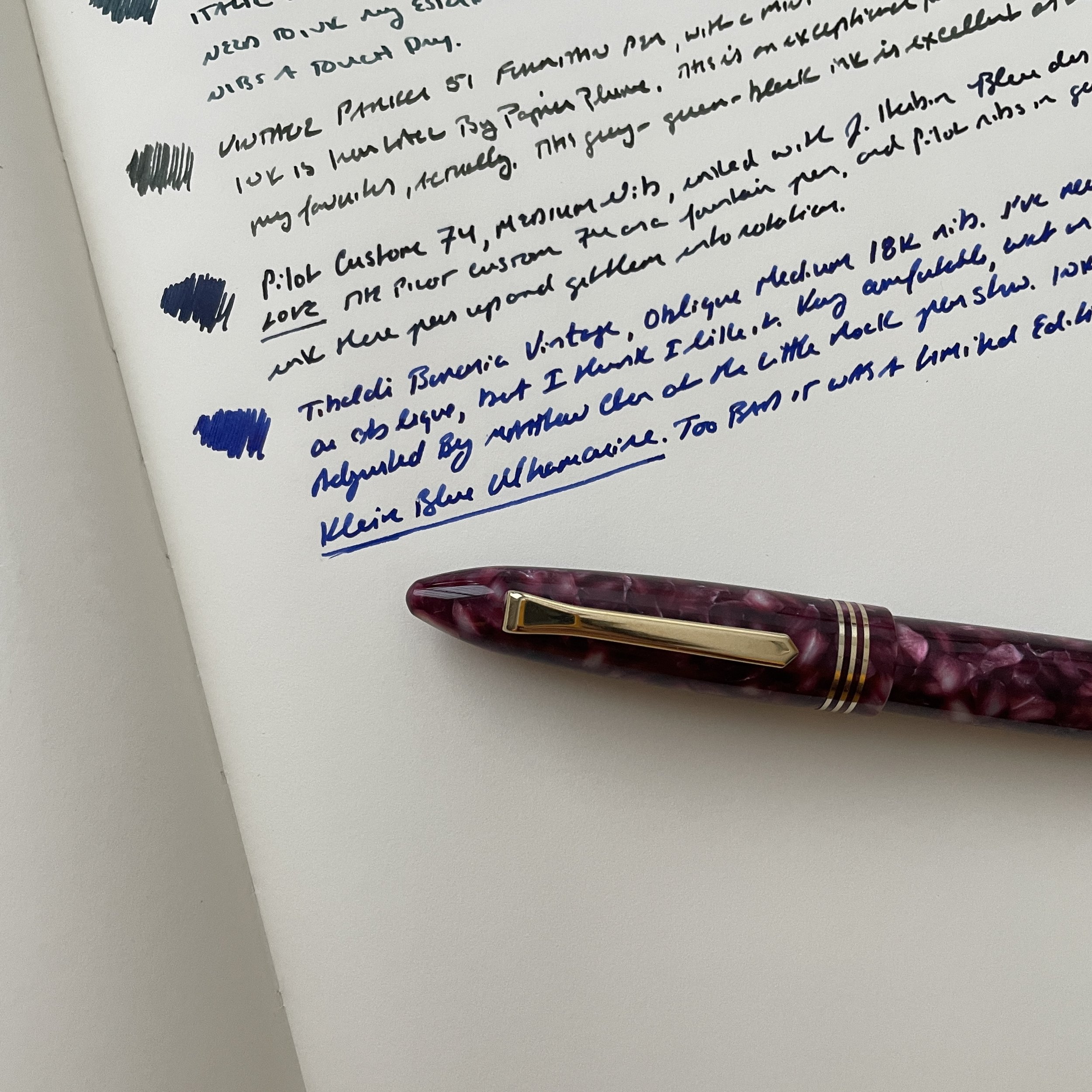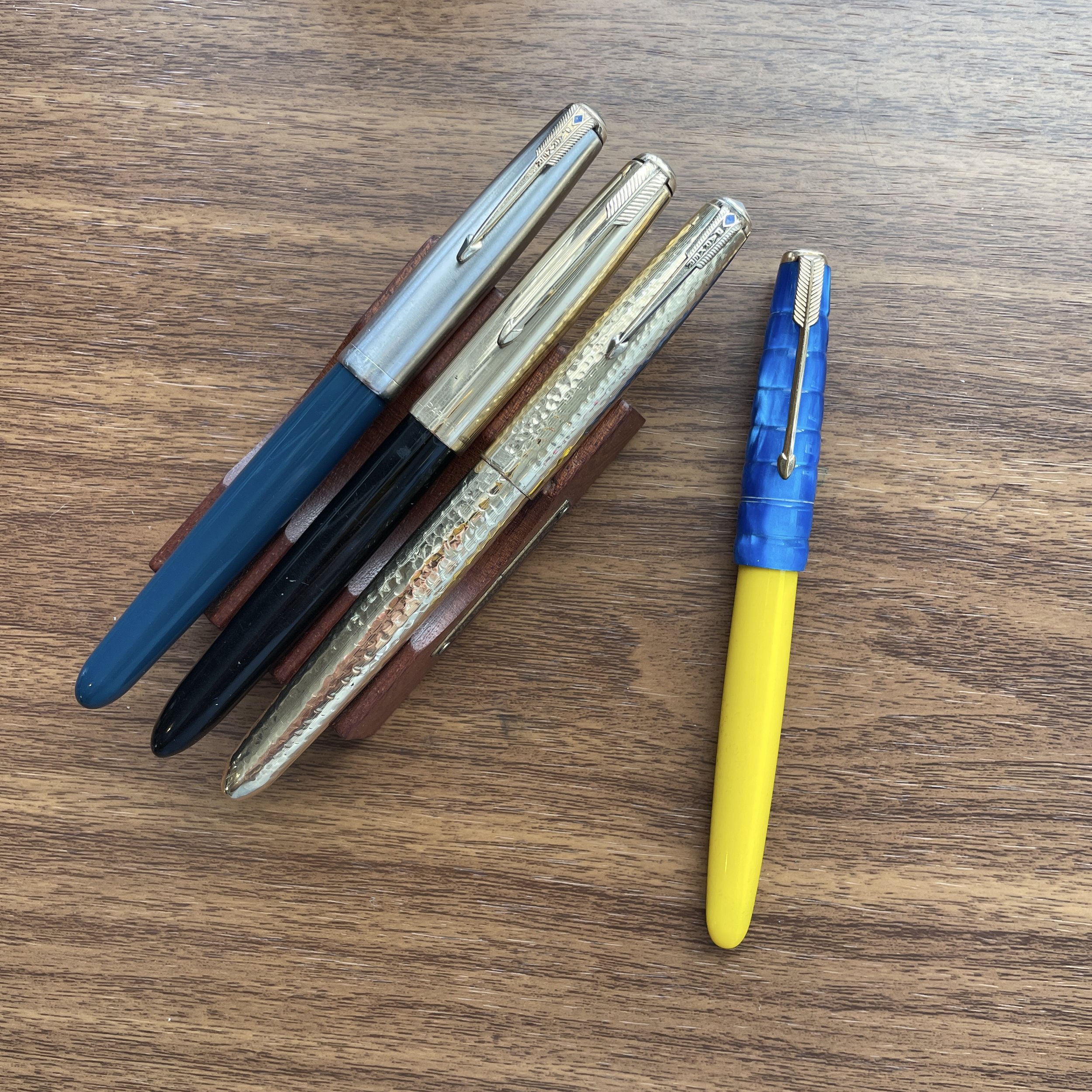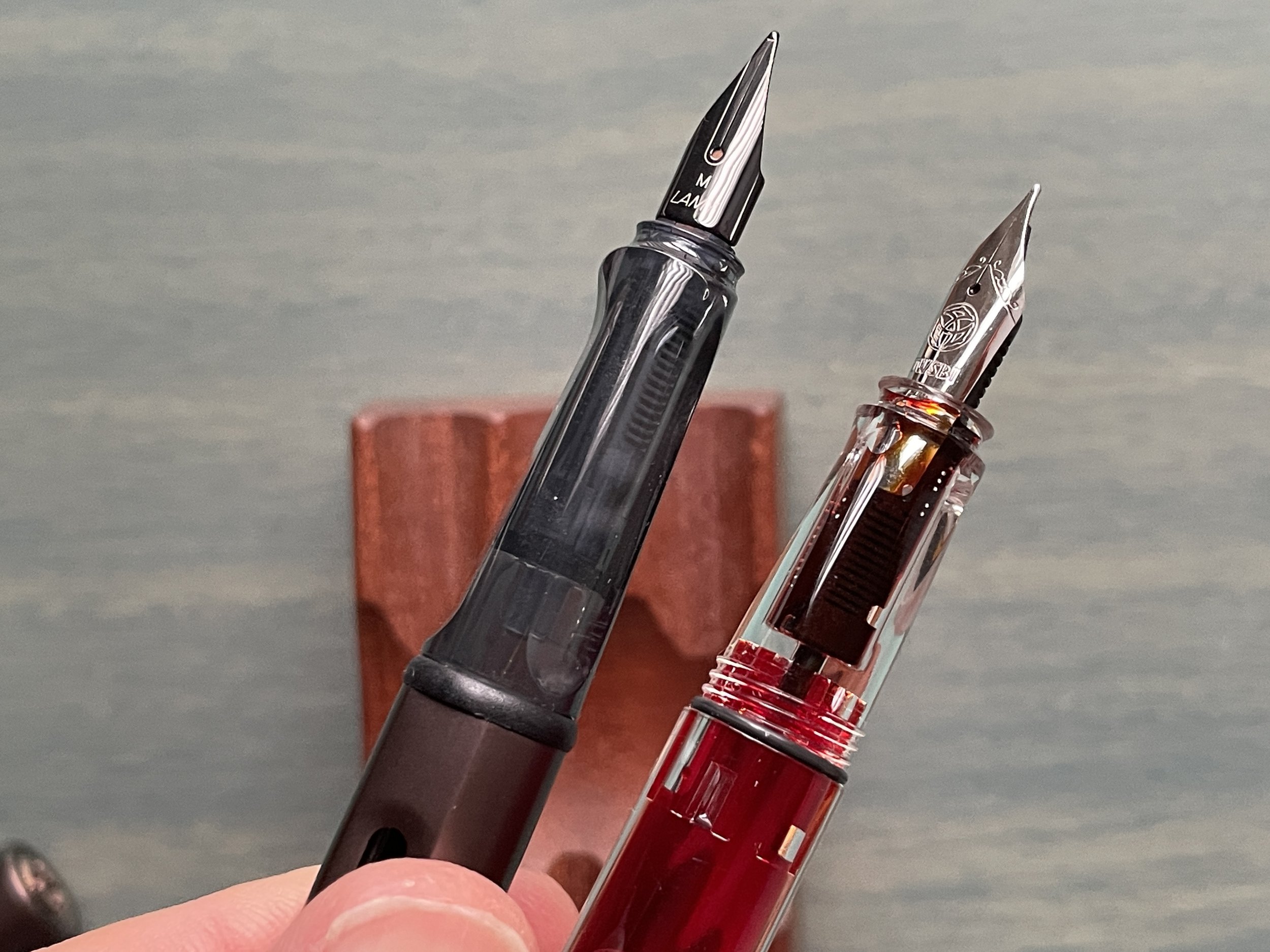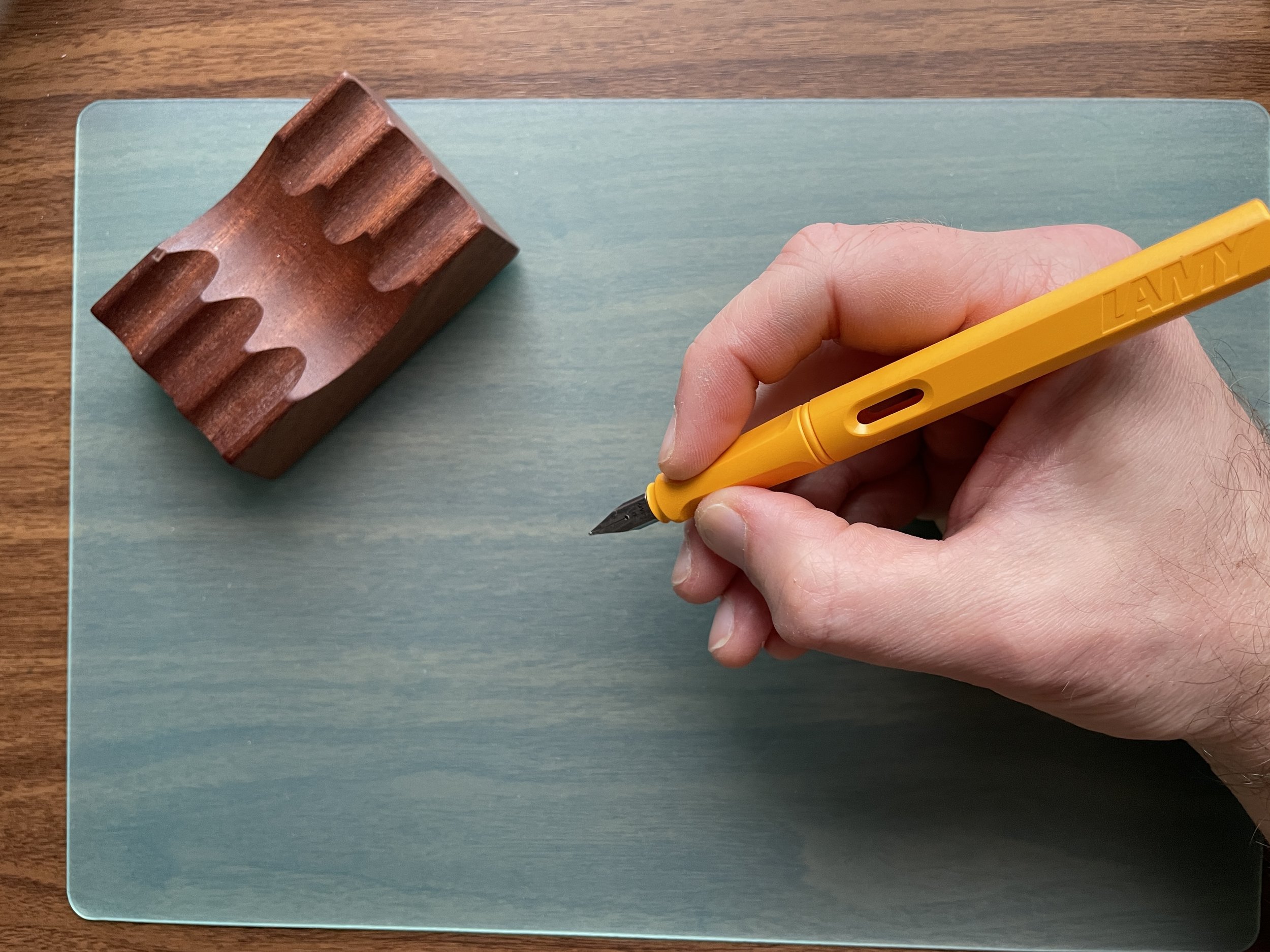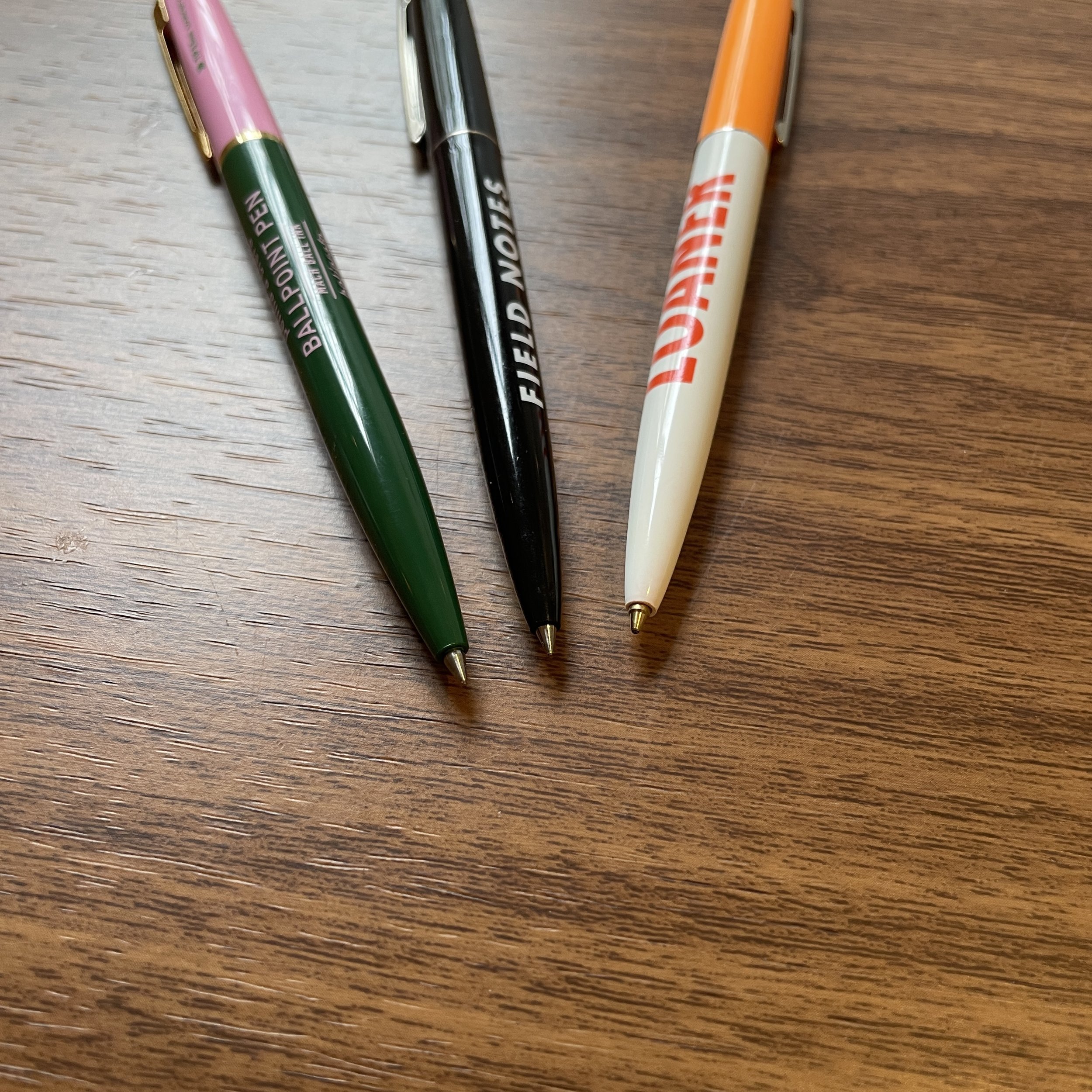Funny story - I was initially drawn to this particular pen at the Arkansas Pen Show, having been “forced” to sit next to the Vanness Pens table and eye these two Tibaldi Bononia vintage fountain pens all day on Saturday and most of the day on Sunday. Specifically, I kept eyeing the “Pomegranate” version, with its wine-colored crushed ice/stone acrylic, but I couldn’t get past a perceived problem with the nib. At least three different vendors looked at the tipping, and all of us concluded that while it wrote “OK,” the tipping on the nib was lopsided. Deflated, I walked back to the table and put the pen back in the box, at which point I noticed the large “OM” (Oblique Medium) on the price tag. (It also appeared on the nib, but none of us noticed that either.) I dipped the pen, angled the nib as intended with an oblique, and the pen wrote perfectly.
The two materials shown here are “Pomegranate” (left) and “Honeycomb” (right).
Self-deprecating humor about us “pen experts” notwithstanding, this story is also revealing simply because it never occurred to me that a modern company, much less Tibaldi, would release a pen with an oblique medium nib. Once fairly common stock nib options, but increasingly rare, oblique nibs are useful for those who angle their pens as they write. This particular nib is a “right-footed” oblique, with the nib tipping angled on the right side (like a right foot) to accommodate someone who rolls the pen to the right as they scribble away.
The Tibaldi Bononia Vintage is available in stock oblique medium nibs (shown at left) and a factory stub, which I believe is 1.1mm (shown at right). You can see how the tipping material on the oblique is slightly angled.
It’s a fun lead-in to a review of an excellent pen with well-executed vintage styling. Italian penmaker Tibaldi has a long history, and in recent years has mounted something of a comeback, reissuing modern versions of pens from its archive such as the “Bononia” model. (“Bononia” is the Latin form for “Bologna”, though Tibaldi is not headquartered there, was founded in Florence, and is now headquartered in Bassano del Grappa near Montegrappa, with which the company shares common ownership.)
I love the low threads on the section, which make it easier to grip the pen comfortably. These threads are also short, and allow you to cap/uncap the pen quickly.
Of all the pens in the Tibaldi lineup, the Bononia holds the most visual appeal for me personally, but with relatively sparse distribution in the U.S., I’ve never had the opportunity to see one in person. I ended up borrowing two of the limited edition “Bononia Vintage” models from Vanness for review, mainly because there’s an open spot in my own collection for a streamlined/torpedo-shaped pen that hasn’t yet been filled, and I like the size of this particular pen more than something like an Oldwin, which while gorgeous, is probably too big for me to use regularly.
What I love about this design:
The short barrel threads are located at the end of the grip section, down near the nib. Not only is the pen quick to cap/uncap (1-1.5 turns!?), but there’s little to no contact with your fingers as you write, unless you grip the pen VERY close to the nib.
The piston-filling system feels high quality and holds an adequate amount of ink. I’ve been writing regularly with this pen for the last week or so, and it still writes a wet line with no sign of slowing down. I’d estimate it holds 1-1.5ml of ink in the barrel.
The Bononia posts deeply and sits well in the hand posted or unposted. The acrylic is gorgeous, with a lot of depth. Despite some added heft from the piston system, which feels like brass, the pen is well-balanced even when posted.
Back to the nib: One complaint I’ve heard about modern Tibaldi is that the nibs tend to dry out, and write on the drier side in general. This was my experience with the steel nib N.60 I reviewed a couple of years ago. I had no such issues with the oblique nib on the Bononia Vintage, which is 18k gold and is paired with a plastic feed that delivers steady ink flow. I’ve written with this particular nib on multiple papers using Caran d’Ache ink, and had no problems - the nib lays down a wet line, generally smooth with just a touch of tactile feedback. (Note: I also wrote with the stock stub, and found it a less appealing drier writing experience, though stock stubs can be temperamental with my handwriting, especially if I’m trying to write fast.)
I love the line this nib writes. The writing sample shown here is done in Caran d’Ache Klein Blue (limited edition) Ultramarine, which is no longer available. I’ll be writing more on Caran d’Ache bottled inks soon, as we intend to add them to the shop. The paper is a Midori MD Cotton notebook, which has become my preferred paper for ink testing, if not for writing in general.
Takeaways and Where to Buy
The Tibaldi Bononia Vintage is currently still available from select retailers, including our friends at Vanness Pens. Priced at $695 MSRP / ~ $495 retail, this isn’t an inexpensive pen by any means, but at the same time the price isn’t outrageous for a piston filler with an 18k nib. Personally, I’m torn on whether to go ahead and purchase this pen. It’s a gorgeous piece, and I’ve long wanted a medium oblique nib in my collection, but at the same time I’ve bought a TON of pens lately, and I’m somewhat drowning under the weight of my current collection, bothered by the fact that exceptionally good pens simply aren’t getting used. That doesn’t change the fact that I love what Tibaldi has created with the Bononia Vintage, and look forward to seeing more higher-end pens from this manufacturer that draw on their rich archive of classic designs.
The Tibaldi Bononia Vintage (left) compared against a Pilot Custom 74 (center) and a Lamy 2000 (right), two commonly available fountain pens for size reference. Also, you may notice that I’m writing with a Midori MD Cotton Notebook inside a MD A4 Paper Cover. The F3 size fits the A4 cover - at least the paper one.
This pen was loaned to me by my friends at Vanness Pens for review purposes, at no charge. I have not otherwise been compensated for this review. The Gentleman Stationer is currently supported entirely by purchases from The T.G.S. Curated Shop and pledges via the T.G.S. Patreon Program. If you enjoy our content and wish to support us, please help us stay ad and affiliate free by shopping with us or becoming a member.


